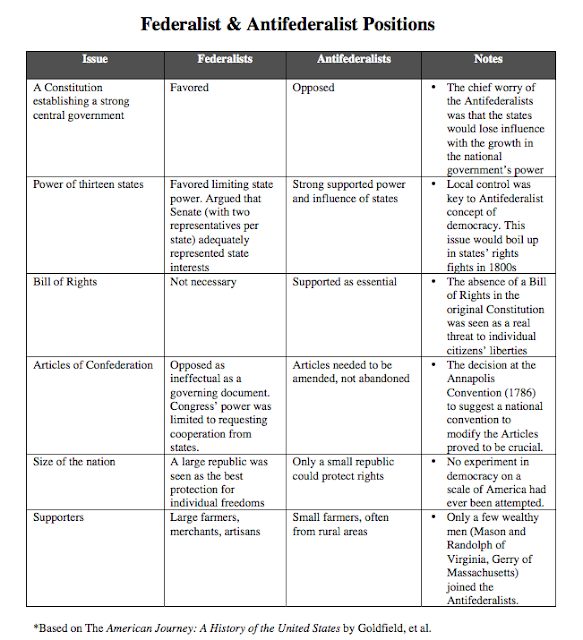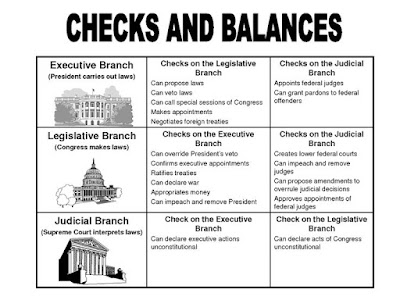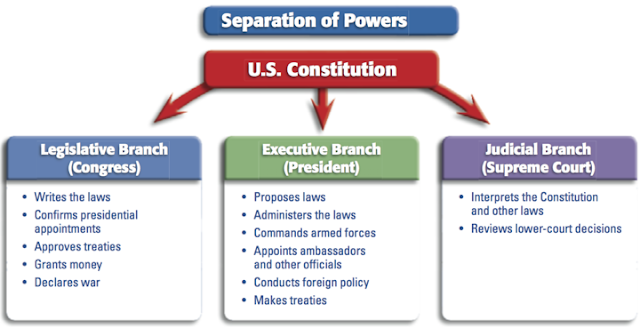Homework due Today: Read and answer the questions from this Annotated Brutus I
Homework due Tuesday: Read and answer the questions from Federalist 51
CONSTITUTION TEST this Friday: Constitution Test Review Sheet (must pass to graduate!)
Unit 1 Identification Terms--you should be done with the first section and working on the second section (Constitution)
Review of Constitutional Principles examples
_________________________________________________________________________________
Learning Objectives:
CON-1.A: Explain how Federalist and Anti- Federalist views on central government and
democracy are reflected in U.S. foundational documents.
democracy are reflected in U.S. foundational documents.
CON-1.A.2: Anti-Federalist writings, including Brutus No. 1, adhered to popular democratic
theory that emphasized the benefits of a small decentralized republic while warning of the
dangers to personal liberty from a large, centralized government.
theory that emphasized the benefits of a small decentralized republic while warning of the
dangers to personal liberty from a large, centralized government.
When the delegates wrapped up the convention and presented the Constitution to the states for ratification in September 1787, it was not a guarantee that it would be approved. Fierce debate took place between Federalists,those who supported this new proposal of government, and their opponents who feared too strong of a central government, the Anti-Federalists. Over the next few days, we will look at the arguments and differences between them.
A number of essays were published in newspapers arguing both for and against ratification. Essays supporting the Constitution were written by John Jay, Alexander Hamilton, and James Madison using the pseudonym Publius. One of the most famous and often quoted of these is Federalist 51, an articulation by Madison of the constitutional features of separation of powers and checks and balances.
There were a variety of opponents to the Constitution using a number of different pseudonyms, but one of the more common names associated with Anti-Federalist papers is Brutus. In Brutus I, the author draws attention to the main concern of Anti-Federalists--too much power given to the national government at the expense of the states.
Brutus believes that the national government under the newly proposed constitution will be similar to Thanos. Using this analogy, what are the "infinity stones" that the national government will possess that will be the source of their immense powers? You should be able to find at least 5 federal powers that the government will have that Brutus is concerned about. What will be destroyed by a national government "snap"?
Here is a handy comparison chart of their different positions:
Based on the above chart, try to identify these statements as either Federalist or Anti-Federalist positions:
1. “I think those delegates exceeded their authority in creating a whole new government. They were just supposed to work on the Articles a bit.”
2. “What Americans need is a bill of rights, and this new government will not get my approval until we have one.”
3. “I think this new plan will provide a good balance of power.”
4. “Those people want to make the United States undemocratic and get special privileges for a limited few Americans.”
5. “It’s obvious that the Articles weren’t working, and I think this new plan reflects a careful compromise among a variety of opinions.”
6. “I and my two friends wrote our essays under the name ‘Publius’ because we wanted people to be influenced only by the facts.”
7. “If we give too much power to a central government, what’s to stop the United States from becoming a monarchy like Britain?”
8. “I think it’s important for people to realize that the large size and diversity of the United States will make it impossible for any single group to form a majority that could dominate the government.”
9. “I encouraged the delegates at the Convention to sign the Constitution and I fear that this nation will crumble if the states do not accept it.”
10. “I’m just a simple farmer, but I think those supporters of the Constitution expect to get all the power into their own hands.”
Now let's try the same thing, but with actual quotes from Federalist/Anti-Federalist papers.
Diffen: Anti-Federalists vs. Federalists
Docs of Freedom: The Ratification Debate
This Nation: Ratification
A good visual explainer on Federalist 51:













